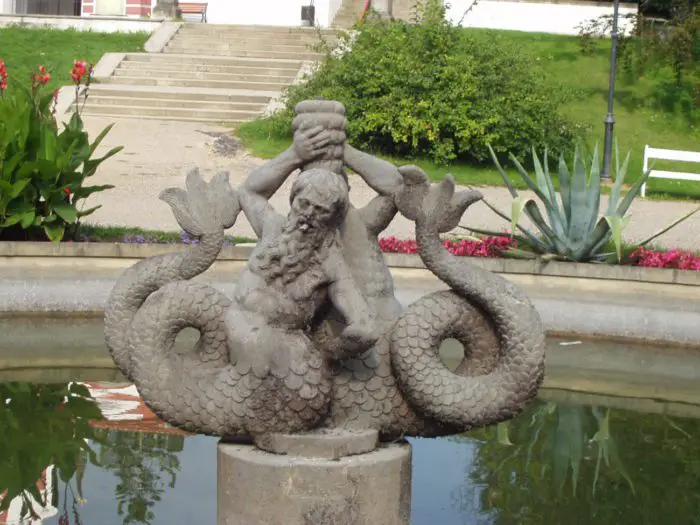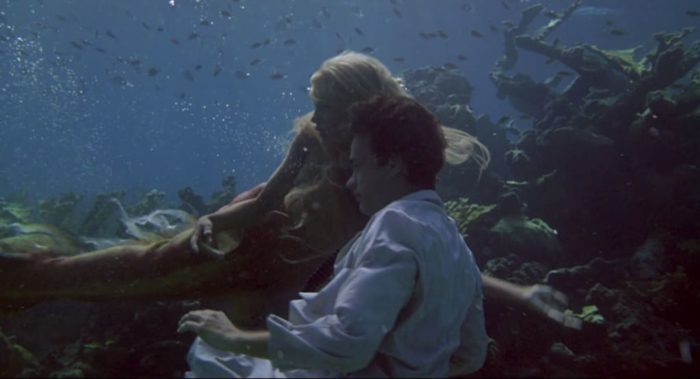Of course, when I think of mermaids, The Little Mermaid comes to mind. The well-known animated Disney version wasn’t around yet when I was a child. I was introduced to the fairy tale written by Danish writer Hans Christian Andersen about a mermaid who gives up the life she knows in the ocean to become human. I had mermaid dolls and also recall the 1983 movie Splash starring Tom Hanks and Daryl Hannah, about a mermaid in New York City who has a relationship with a human man. Mermaids were always portrayed as benevolent feminine half-human/fish hybrids.
However, as I got older and came across bits and pieces of mermaid lore, the original tales painted a much darker picture of a mermaid. Sometimes, mermaids were often equated with sirens of ancient Greece who sang songs and lured men to their deaths.
History and Folklore
According to a 2019 article, “Myths, Folklore and the World of Mermaids,” on Mysterious Universe, the word “mermaid” is derived from the old English words for sea “mere” and woman “maid.” In English folklore, mermaids weren’t considered benevolent beings but quite the opposite. They were considered to be a sign of impending doom or the cause of it.
Mysterious Universe cites the 18th-century Scottish ballad, “Sir Patrick Spens,” as depicting a mermaid speaking to ships in danger. There are various versions of the ballad. In some, the mermaid tells the crew that they will never see land again. In another version, she tells them that they are approaching land. In both, the men don’t trust the mermaid and suspect deception.

However, mermaids do not belong to British lore alone. A 2022 article, “Mermaids and Mermen: Facts and Legends” on Live Science points out that mermaid-like beings pop up in mythology in cultures around the world from Babylon to Scotland, Wales, Japan, and Africa. According to writer Benjamin Radford, the earliest depiction of a mermaid-type being is in Syrian mythology in the form of the goddess Atargatis, also known as Derceto, revered in the ancient city of Hierapolis-Bambyce. Radford also goes on to say that even in modern times, Hinduism and Candomble, which is an African-Brazilian religion, include mermaid-like goddesses.
In Japanese lore, there’s a being called a kappa that lives in lakes, coasts, and rivers. Kappas are small, child-sized water spirits with apelike faces and tortoise shells on their backs. Kappas challenge humans to play for their life in games of skill. They also like cucumbers and hunt children swimming alone in isolated places.
Lore in parts of Africa includes a water spirit called Mami Wata (Mother of the Waters), who was worshiped at one time. Believers thought that she could grant beauty, health, and wisdom to her followers.
Sirens
Getting back to the sirens of ancient Greek mythology, the 2021 article, “What Was a Siren in Greek Mythology?” on Mythology Source, points out that, at first, sirens were originally hybrid woman-bird beings. Like their later sea-dwelling counterparts, sirens lured sailors to their death by singing songs with lyrics in voices described as irresistible. How the sailors died isn’t agreed on. Some sources say that their ships perished on the rocks, however, Homer is cited as describing fields of rotted corpses implying that the sirens were cannibals. Sirens played a part in two major stories in ancient Greek literature, The Odyssey and The Argonautica. In both stories, the sailors escape the sirens.
In Argonautica, Jason and his crew escape thanks to the musician Orpheus whose playing drowns out the sirens’ song. In The Odyssey, Odysseus’ crew sealed their ears with wax and Odysseus tied himself to the mast to keep from losing control of himself once he heard their song. Part of the lore was that if anyone survived hearing the siren’s song, the siren would die.
According to Greek mythology, sirens were the handmaidens of Persephone, Queen of the Underworld. Therefore, sirens were linked to death. In some tales, sirens were very sexual beings, but in others, they offer wisdom to humans they interact with. In most tales, sirens lead humans to death.

Mermen
Mermen aren’t discussed nearly as much as mermaids but were included in mythology. Up until the fifth century BC, sirens were depicted as both male and female. After this point, sirens were exclusively female. Besides sirens, Greek mythology included Triton, who is described as a merman. The son of Poseidon and Amphitrite, Triton was the “messenger god of the sea.”
Scottish lore includes the Blue Men of the Minch who live in the Outer Hebrides off the coast of Scotland. The Blue Men will capture a ship and challenge the captain to a rhyming contest. If the captain wins, he and his crew are spared. Dubbed the Blue Men because of their blue complexion, these fish-man hybrids also have gray beards.
Sightings
Stories about actual mermaid sightings date back to medieval times with sailors claiming to encounter mermaids on their travels along with whales. Two notable mermaid sightings, included in the Live Science article, are from the 17th century. One story comes from Holland which was included in the book The Flying Dutchman and Other Folktales from the Netherlands by Theo Meder, which tells about a mermaid who injured herself when she came into Holland through a dike. The story goes on to claim that the mermaid was cared for by locals and eventually became a Dutch citizen.
The other encounter from 1614 is taken from Edward Snow’s “Incredible Mysteries of the Sea.” A sea captain off the coast of Newfoundland describes the following mermaid encounter from 1614: “Captain John Smith [of Jamestown fame] saw a mermaid ‘swimming about with all possible grace.’ He pictured her as having large eyes, a finely shaped nose that was ‘somewhat short, and well-formed ears that were rather too long.’ Smith goes on to say that ‘her long green hair imparted to her an original character that was by no means unattractive’” Smith was reportedly so attracted to the mermaid that he experienced “the first effects of love” before noticing her fishtail.
Of course, mermaid sightings are simply a case of mistaken identity. For example, manatees are usually said to be mistaken for mermaids. Looking at a manatee, you can see how, to the 17th-century eye, it may appear to be a human-fish hybrid. Their flippers are kind of arm-like and their tale does resemble popular depictions of a mermaid’s tail.

Mermaids Today
I was surprised to learn that people still do claim to see mermaids. According to Live Science, locals in the town of Kiryat Yam, located off the coast of Israel saw a mermaid in 2009. One of the people who claimed to see the mermaid, Shlomo Cohen, is quoted: “I was with friends when suddenly we saw a woman laying on the sand in a weird way. At first, I thought she was just another sunbather, but when we approached she jumped into the water and disappeared. We were all in shock because we saw she had a tail.” Even though the town offered a $1 million reward to the first person to photograph the mermaid, the reports suddenly stopped.
For the past 800 years, a temple in Fukuoka, Japan had preserved the bones of a mermaid found washed ashore in 1222. According to Live Science, water used to soak the bones is believed to have healing properties. A priest insisted on preserving the bones. He believed that the creature came from a sacred palace at the bottom of the ocean that was the home of a dragon god. Currently, not many of the bones remain and they haven’t been tested to determine their origin.
The FeeJee Mermaid
Over the years, there have been many mermaid hoaxes from the 19th century to the many so-called mermaid sightings posted on YouTube. One of the most notable is the FeeJee mermaid, which was what was said to be a preserved mermaid carcass that was put on display during the 1840s.
P.T. Barnum, who would become known as a “master showman,” put the FeeJee Mermaid on display for the curious to come and see for 50 cents. The FeeJee Mermaid was a far cry from the stunningly beautiful sea nymph with long flowing hair. It was found out later that the FeeJee Mermaid was an ape torso sewn on a fishtail. A 2016 Live Science article, “The FeeJee Mermaid: Early Barnum Hoax,” quotes P.T. Barnum’s description of the mermaid from his autobiography: “[…]an ugly dried-up, black-looking diminutive specimen, about 3 feet long. Its mouth was open, its tail turned over, and its arms thrown up, giving it the appearance of having died in great agony.”
However, people came out in droves to see the FeeJee Mermaid and it became one of P.T. Barnum’s most popular attractions. The FeeJee Mermaid went on display in New York, Boston, and London. There isn’t any further information as to what happened to the FeeJee Mermaid. It was, however, one of many mermaid carcasses reportedly displayed during the 19th century and the most popular.

YouTube and Animal Planet
The FeeJee Mermaid was one of many hoaxes from the age before TV and radio were available to the public. However, mermaid hoaxes continue using modern technology. If you go on YouTube and search under “mermaid sightings” tons of videos pop up.
Cable TV network, Animal Planet, aired a mockumentary in 2012, Mermaids: The Body Found In this fictitious documentary-style film, scientists present proof of the existence of mermaids. Despite disclaimers, many viewers were convinced. Live Science reports that the National Oceanic and Atmospheric Administration released an official statement to confirm that mermaids do not exist.
Mermaiding
According to the National Oceanic and Atmospheric Administration, no evidence of mermaids has ever been found. However, if you really love mermaids, you can always try mermaiding. Mermaiding is wearing or swimming wearing a mermaid costume. A person can do this on a professional basis or as a hobby. Writer Elizabeth Kiefer reports in a 2019 article for the Washington Post, “‘Mermaiding’ is suddenly everywhere. But is it a real workout?” that there are even mermaid classes. Metro Merfolk organizes classes for mermaids as well as meet-ups. Metro Merfolk co-founder Colleen “The Celtic Siren” McCartney teaches wannabe mermaids how to swim with a tail with an eight-class course in Washington D.C.
And They Lived Unhappily Ever After?
Mermaids, like many other mythological creatures, have been part of folklore for thousands of years. Like their other mythological counterparts, vampires and shapeshifters, versions of mermaids pop up in mythological lore from around the world. While mermaids haven’t always had a dark reputation, they were originally associated with death. Mermaids have also experienced a shift from benevolent back to their original sinister origins. The horror genre has finally embraced mermaids, mostly in independent films so far, including films such as Killer Mermaid (2014) and Mermaid: Lake of the Dead (2018). Perhaps, mermaids will one day be thoroughly embraced as an official member of the horror pantheon of classic monsters alongside vampires, werewolves, and the often underappreciated Gill-Man, aka the Creature from the Black Lagoon. Who knows? Maybe we’ll see a cross-over someday.



